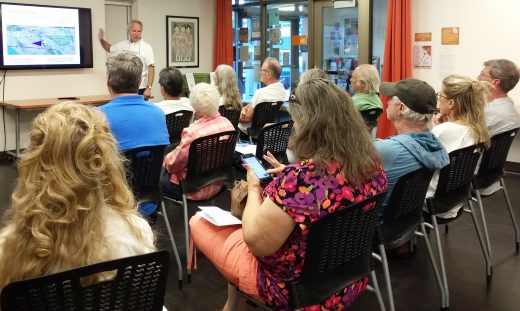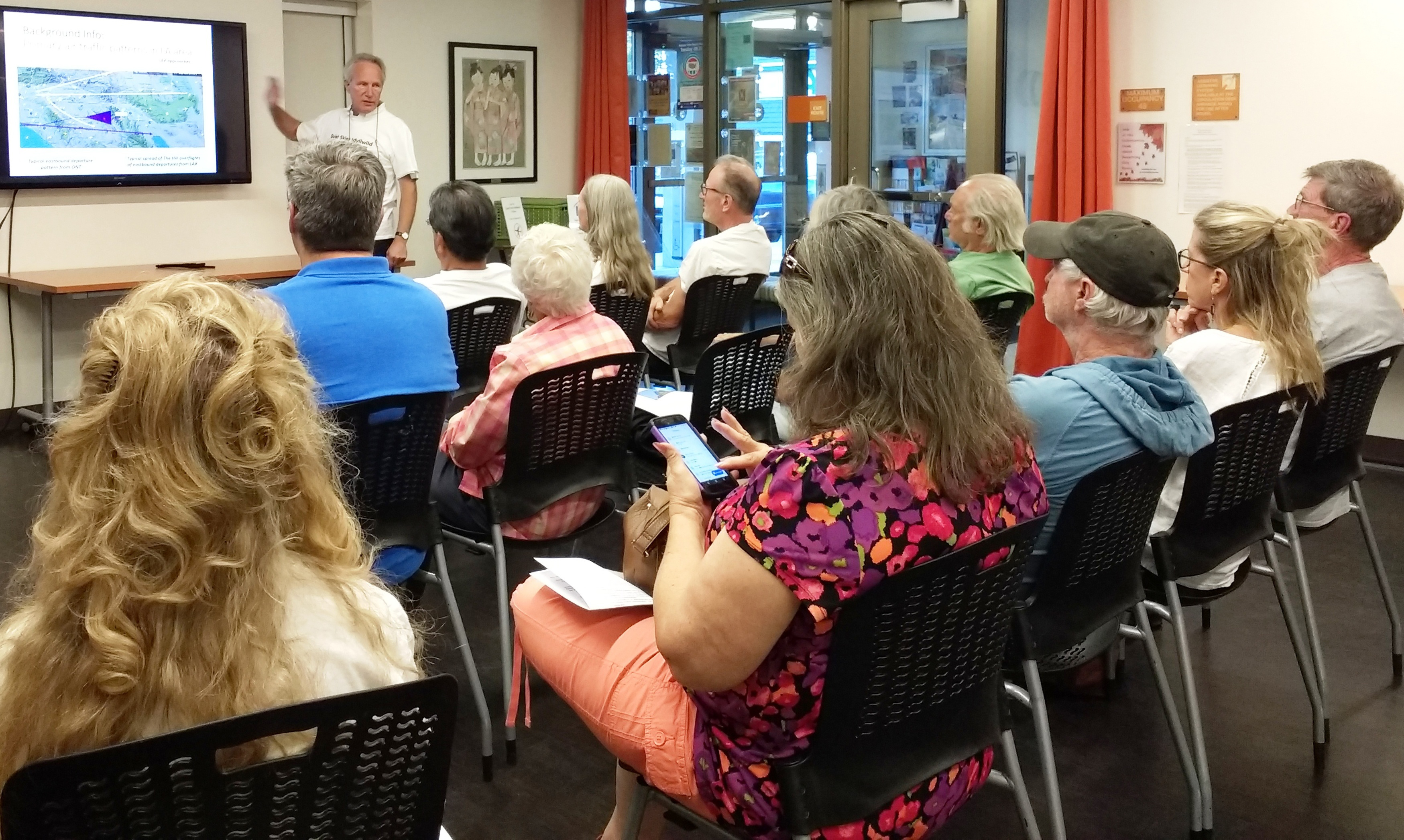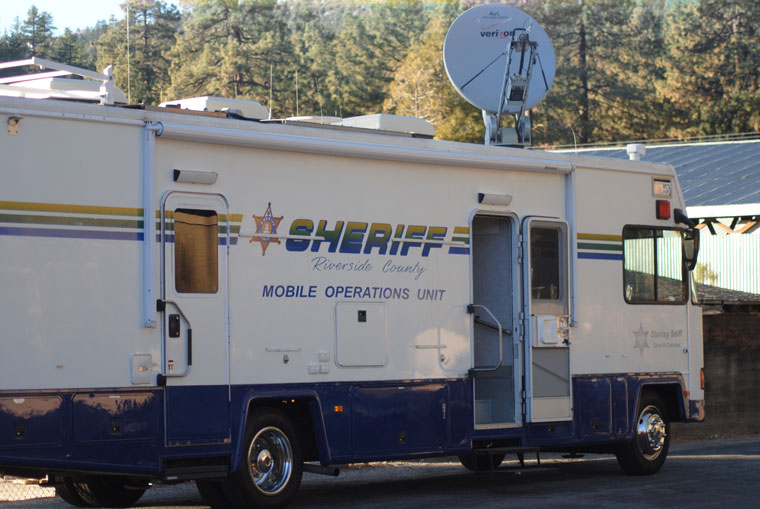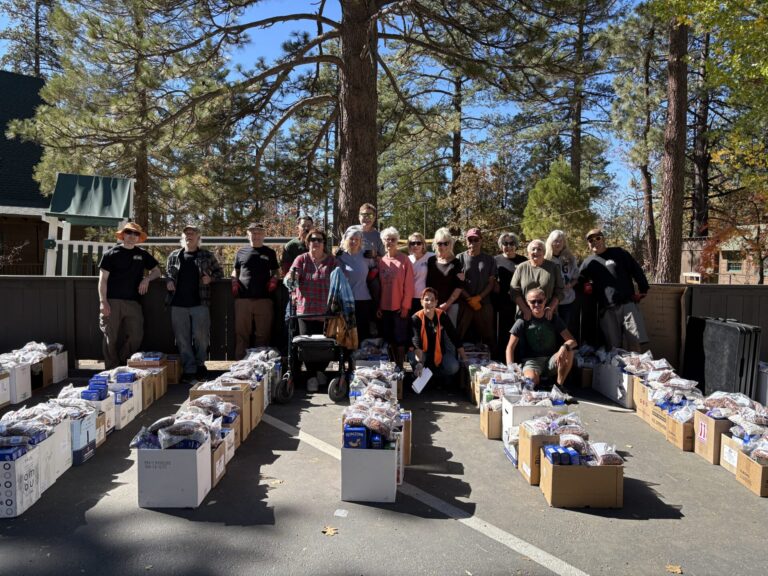
Photo by Debra Varnado
Quiet Skies Idyllwild is reaching out to get help from more people in the 92549 zip code in their effort to get the Federal Aviation Administration to reroute noisy, polluting jet aircraft away from the Hill.
At its Sept. 18 community meeting at the library, QSI members objected to having their sleep and daily activities disturbed, and the potentially damaging effects on the Hill’s economy, environment, wildlife and wildlife habitats, the forests, wilderness areas and nearby national monuments.
Residents expressed dissatisfaction with the FAA’s process for the public to review and comment on NextGen, which changed arrival and departure procedures and altitudes at so-called “Metroplex” airports in California and around the country.
Group spokesperson David Pearson said, “Public meetings to discuss NextGen’s impact on the skies of Idyllwild were not held on the Hill. The new procedures were put in place with inadequate opportunity for residents to participate in the vetting process.
“Planes departing eastbound from Los Angeles International and Ontario airports are now directed by computer algorithms directly over the Hill. NextGen’s new aircraft flight paths … have destroyed peacefulness on the mountain.
“It didn’t use to be this way,” Pearson lamented. “Computers are saving the air carriers gas expenses and reducing carbon footprints by routing their flight paths over the Hill, but there has been limited consideration of the physics of sound, its impact on human and wildlife quality of life, and the special ‘singing bowl’ topography of the Hill.
“The singing bowl refers to the mountain ridges surrounding our communities. They form a series of natural bowls in which sounds reverberate, particularly jet engine noise from over-flights.
“Our Quiet Skies Idyllwild petition urges the public, and state and county representatives to help establish a dialog with the FAA. So far, the correspondence sent by U.S. Congressman Raul Ruiz to the FAA has not been answered,” Pearson said.
The Hill — zip code 92549 — is among scores of communities around the country that have mobilized to oppose NextGen, which FAA rolled out in late 2016 and early 2017. It affected LAX and Ontario, as well as John Wayne, San Diego, Palm Springs International and other airports in California and across the nation.
The FAA stated that the air traffic control transition from radar ground control to satellite-based and digital technologies was “not expected to require any ground disturbance nor increase the number of aircraft operations.”
But that transition — the implementation of NextGen — has caused an increase in noise, the number of jets flying at lower altitudes over homes, and substantial pushback from residents, businesses and political representatives in affected communities.
Pearson emphasized, “FAA and LAX break the noise complaints down by zip code. We have enough data to make a case and we are not just complaining. Our legislators are saying we need public support.”
Jeff Hixon echoed that comment: “That’s why we need to get as many people involved from this zip code.”
Hixon said he had spoken to people in Lake Arrowhead. “It got so bad that one of the leading proponents of the anti-flyover movement is a realtor, somebody who has been selling real estate in Lake Arrowhead for almost 40 years. That’s how serious they’ve gotten. So, now are our jobs threatened? Is real estate threatened?
“We are not at that point necessarily, but it could get there and that’s why it is so important to learn what we can do. They were very well organized. Lake Arrowhead has more than 3,500 participants in their Quiet Skies initiative. They even got a meeting with an FAA representative. They have mitigated some of the flyovers …”
“By working through our legislative representatives, we are asking the FAA to re-route air traffic to previously used flight paths, over sparsely occupied areas to our south, which do not suffer from the unique sound reverberation effects characteristic of the Hill,” Pearson added.
“Already, we have 333 petition-signers on Change.org. Hopefully, our efforts will lead to quiet skies again over Idyllwild by re-routing traffic away from the Hill.”
In the meantime, Idyllwild sky-watchers continue to document air-traffic volumes and patterns over the Hill using smart phones, apps and data from commercial flight trackers. Pearson has created graphs and charts demonstrating that, “The planes are typically 17 minutes out of LAX and still climbing when they fly over Idyllwild. Jet engines make the loudest noise during ascent,” he said.
“Planes flying over us are usually at an altitude of 15,000 to 30,000 feet, leaving a 60- to 90-second noise signature and a trail of pollution. On a busy day, this can be every two to three minutes, or up to 250 flights a day.”
Resident Keith McCabe was quick to point out that “30,000 feet is not high enough.” Morgan Cannon wondered: “Rather than changing the path, ask the FAA if it would be possible to continue out from LAX over the ocean another 10 miles. If the planes could gain altitude, by the time they loop around here, they would have an additional 5,000 feet in altitude. Would that make a difference?”
Pearson responded, “It’s a valid idea. We’ll think about that a little bit further. We don’t have all the technical answers to analyze the singing-bowl effect. We’re trying to find someone.
“We have a lot to learn from people who are active in Quiet Skies and we have been contacted by someone who is organizing Quiet Skies groups in L.A. We are making contacts with people in other parts of the nation, at least 30 to 40. We are going to enlist power and leverage from other people to help us be successful.”
Hixon and wife Helen indicated that residents and visitors can make an impact using their smart phones and apps.
Jeff described GPS-based Airnoise. “You see the airplane and with the click of a button — and because of GPS coordinates and flight radar — the app knows the flight, the carrier, the destination and more. As soon as you click it, the app files an automatic complaint with LAX, the FAA ombudsman and several other relevant parties.”
“It doesn’t quite work on the Hill,” Helen said, “but as soon as it does, we’ll get [access to] them and make sure that everyone who wants one can get one.”
Helen described another app which involves “… the complaints going directly to LAX. They send you back a ‘robo’ response and then after 30 days or so they send a report. What it does is … record data points. When or if L.A. Mayor Eric Garcetti wants to expand LAX and is asked, ‘Has LAX gotten any noise complaints?’ the caller’s complaints will be on record.”
Jeff estimated the daily volume of complaints that could be generated on the Hill: “Among 15 or 20 of us, [that’s] 700 complaints, or 8,000 complaints if there are 300 people.”
Material distributed at the meeting included ways in which 92549ers can help to bring quiet skies back to Idyllwild, among them: signing the online petition at www.change.org/p/raul-ruiz-quiet-skies-for-idyllwild or a paper version. Signatures will be provided to Ruiz, and senators Kamala Harris and Diane Feinstein.
The public also can contact those political representatives and Riverside County Supervisor Chuck Washington directly; report aircraft noise to the FAA and LAX; check on availability of the Airnoise app; and enlist friends to join the movement.
Quiet Skies Idyllwild meets at 4 p.m. Mondays at Mountain Pottery on North Circle Drive.







